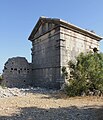Mezgit Kalesi
Coordinates: 36 ° 28 ′ 2 " N , 34 ° 1 ′ 37.5" E
Mezgit Kalesi ( Mezgitkale , also known as the Mausoleum of the Fearless King, Turkish Korkusuz Kral Mezarı ) is a Roman temple tomb in Rough Cilicia from the 2nd or 3rd century in the Silifke district of the Turkish province of Mersin .
location
Mezgit Kalesi is near the village of Öztürkmenli, about ten kilometers west of Kızkalesi and about the same north of Silifke. In the seaside resort of Atakent (the ancient Korasion , formerly Susanoğlu), at the eastern end of the town, a road branches off from the coastal road D-400 to the north in the direction of İmamlı . After about eleven kilometers you reach the Roman ruins of Paslı , where another road turns right to Öztürkmenli. After another two kilometers, you will reach Mezgit Kalesi.
description
The grave has the shape of a tetraprostylos and stands on an area of about 9.2 × 7.7 meters plus a no longer existing flight of stairs 2.5 meters deep. The height is 7.8 meters, the burial chamber is roughly square with a side length of 4.9 meters. The four columns in front and the ante have Corinthian capitals with smooth, unfinished leaves. On the left side of the staircase there is a phallic relief , which is considered an Olbic symbol and stands for Hermes in his function as a psychopompos . A rectangular frame has been preserved in the pediment, which may have had a medallion or an inscription. On the back gable field, three reliefs can be seen depicting a sword, a shield and possibly a scorpion. Hansgerd Hellenkemper and Friedrich Hild consider it possible to interpret the reliefs as defensive hangings, but indicate poor lighting conditions. Four consoles protrude halfway up the columns, presumably bearing busts or statues of the grave owners.
In the burial chamber, the tombs were arranged on two levels, nothing of which has survived. Only the consoles on which the upper level rested are still there. The chamber was probably used as living space in the early modern period. For this purpose, a ceiling made of wooden beams was put in on the consoles and a chimney was built into the back wall. Its trigger was broken into the back wall of the burial house. This type of re-use is known from the Middle Ages for castles in Cilicia , but in the case of ancient buildings it was not until the time of resettlement by Turkish semi-nomads in the 17th and 18th centuries. At the back of the tomb there are walls that belong to a building with at least two stories. Other remains of the wall in the vicinity as well as cisterns and the ruins of an oil mill can be assigned to an agricultural estate from the late Roman-early Byzantine period. Hellenkemper and Hild date the grave, like most of the Roman grave structures in the Rough Cilicia, to the 2nd or first half of the 3rd century.
It is not possible to clarify what the often used popular name “Mausoleum of the fearless king” comes from.
literature
- Hansgerd Hellenkemper, Friedrich Hild: New research in Kilikien. Publications of the commission for the Tabula Imperii Byzantini Volume 4, Verlag der Österreichischen Akademie der Wissenschaften , Vienna 1986 pp. 57–58 ISBN 3700107714
Web links
Individual evidence
- ↑ Celâl Taşkıran: Silifke (Seleukeia am Kalykadnos) and surroundings. Sim Matbaası, Ankara 1999 p. 43
- ↑ Kizkalesi and Cilicia







